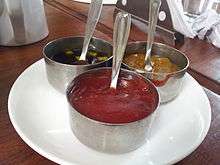Fruit ketchup
Fruit ketchup is a condiment prepared using fruit as a primary ingredient. Various fruits are used in its preparation, and it is also used as a spread and marinade, among other uses. Banana ketchup is a type of fruit ketchup that is common in the Philippines. Some companies mass-produce fruit ketchup, such as Philippines-based Jufran, and Chups, a small company based in Washington, D.C., United States.
Overview
Fruit ketchup is composed primarily of fruit, and is prepared with fruits such as apples, pears, peaches, currants, grapes, cranberries, cherries and plums, among others.[1][2][3] Tropical fruits used in its preparation can include mangoes, guavas, banana, pineapple, papayas and others.[4] Sometimes several fruits are used to create a mixed-fruit ketchup.[5] Chili peppers can be used to prepare a spicy fruit ketchup.[5] Vinegar, ginger and sugar or brown sugar are sometimes used in its preparation.[2][3][5]
Fruit ketchup is used as a condiment in the same manner as the more common tomato ketchup.[6] It is also used as a spread, dipping sauce, marinade, topping and base for salad dressings.[6][7][1] It can be used to top beef and pork and various savory dishes such as meatloaf.[1][3] It is also used as a sandwich spread.[3]

Banana ketchup, sometimes referred to as banana sauce, is a sweet ketchup prepared using mashed banana, sugar, vinegar and spices.[8][9] It is a common condiment in the Philippines, where it is as common as tomato ketchup is in the United States.[8][10] Banana ketchup is mass-produced by some companies and marketed under various brands, such as Jufran.[8]
Technically, due to being made with a lot of sugar and tomatoes (which botanically are a fruit), tomato ketchup is a fruit ketchup too.
Companies
NutriAsia is a company based in Manila, Philippines, that manufactures the Jufran brand of banana ketchup.[11][12] Chups is a small company and brand of fruit ketchup produced in Washington, D.C.[7][13] Chups is produced in six flavors: cranberry, mango, peach, plum, blueberry and spicy pineapple.[7][14]
See also
References
- Stern, Bonnie (November 21, 2014). "Bonnie Stern: Hitting a plateau with recipes inspired by Montreal's hottest restos". National Post. Retrieved June 12, 2016.
- Publication. 1918. p. 58. Retrieved June 12, 2016.
- Ziedrich, L.; Williams, C. (2009). The Joy of Pickling: 250 Flavor-Packed Recipes for Vegetables and More from Garden or Market (revised ed.). Harvard Common Press. p. 349. ISBN 978-1-55832-375-9. Retrieved June 12, 2016.
- Raichlen, S. (2003). BBQ USA: 425 Fiery Recipes from All Across America. Workman Pub. p. 683. ISBN 978-0-7611-2015-5. Retrieved June 12, 2016.
- Tregellas, M. (2012). Homemade Preserves & Jams. St. Martin's Press. p. 52. ISBN 978-1-250-00446-8. Retrieved June 12, 2016.
- Freezing Canning Cookbook. 1964. p. 311. Retrieved June 12, 2016.
- Simmons, Holley (June 30, 2014). "'Chups: Fruit ketchups stirred up by a couple with a passion for condiments". Washington Post. Retrieved June 12, 2016.
- Raichlen, S. (2015). Planet Barbecue!: 309 Recipes, 60 Countries. Workman Publishing Company. p. 44. ISBN 978-0-7611-6447-0. Retrieved June 12, 2016.
- Giles, A. (2016). Beyond Canning: New Techniques, Ingredients, and Flavors to Preserve, Pickle, and Ferment Like Never Before. Voyageur Press. p. 105. ISBN 978-0-7603-4865-9. Retrieved June 12, 2016.
- de Las Casas, D.; Gagatiga, Z.C. (2011). Tales from the 7,000 Isles: Filipino Folk Stories: Filipino Folk Stories. World Folklore Series. ABC-CLIO. p. 148. ISBN 978-1-59884-699-7. Retrieved June 12, 2016.
- "Nutri-Asia Inc.: Private Company Information". Bloomberg L.P. June 12, 2016. Retrieved June 12, 2016.
- Gonzales, Iris C. (January 25, 2016). "NutriAsia to bring condiments business overseas". The Philippine Star. Retrieved June 12, 2016.
- Sidman, Jessica (February 5, 2014). "Local Couple Aims to Make Fruit Ketchups a Thing". Washington City Paper. Retrieved June 12, 2016.
- Martell, Nevin (August 18, 2015). "'Chups Spicy Pineapple". Men's Journal. Retrieved June 12, 2016.
